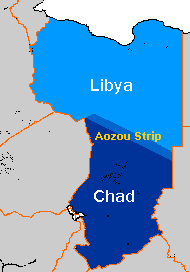Franco-Italian Agreement of 1935

The Franco-Italian Agreement (called often Mussolini-Laval accord) of 7 January 1935 was signed in Rome by the French Foreign Minister Pierre Laval and Italian Prime Minister Benito Mussolini.
History
After the victory in World War I it was agreed that Italy was not going to receive territories from the defeated German colonial empire (that was divided between France and Great Britain) but later would be rewarded some bordering areas from the British and French empires. This was felt by the Italians to be very little compensation for their sacrifices in the bloody war and was one of the reasons of the rise to power in Italy of Mussolini's fascism. The British ceded Oltre Giuba from Kenya to Italian Somalia in 1925, but the French delayed some years until the mid 1930s: they agreed only in 1935, under Foreign Minister Laval's leadership, to give only a small amount of territory in eastern Africa and a desert area in the French Sahara.
Pierre Laval had succeeded Louis Barthou as Foreign Minister after the latter's assassination in Marseilles on October 9, 1934, at the side of the Alexander I King of Yugoslavia. He borrowed from his predecessor the idea of a system of collective security intended to contain the threat of Hitler in Europe. On January 4, 1935, Pierre Laval went to Rome, capital of Fascist Italy, to meet Mussolini. It was the beginning of a diplomatic offensive intended to enclose Adolf Hitler's Germany in a network of alliances.
He proposed a treaty to Benito Mussolini that defined disputed parts of French Somaliland (now Djibouti) as part of Eritrea, redefined the official status of Italians in French-held Tunisia, and essentially gave the Italians a free hand in dealing with the Abyssinia Crisis with Ethiopia.
Italy was also to receive the Aouzou strip which was to be moved from French-ruled Chad to Italian-ruled Libya (this issue would have some implications in World War II and in post-colonial Libya-Chad relations).
In exchange for all these concessions, France hoped (in vain, as it turned out) for Italian support against German aggression.

The Mussolini-Laval accord was signed as a "law" by the French National Parliament on March 26, 1935 [1] but was never accepted by the Italian Parliament because it was judged as too "minimal", not including anything from French Tunisia, Corsica and Nizza.[2]
Main agreements
The Mussolini-Laval accord had the following main agreements:
- A small territory in French Somaliland south of Eritrean Rahayta was to be given to Italian Eritrea.
- The village of Aozou and the surrounding Aozou strip in French Africa Chad was to be given to Italian Libya.
- Italy was allowed (by the French government) to occupy Ethiopia without interferences.
Note
- ↑ 7 janvier 1935 - Accord franco-italien (Laval-Mussolini) (extrait in french)
- ↑ XXIX Legislatura del Regno d'Italia (in Italian)
Bibliography
- G. Bruce Strang: Imperial Dreams: The Mussolini-Laval Accords of January 1935. In: The Historical Journal 44, September 2001, 3, ISSN 0018-246X, pp. 799–809.
- R. Festorazzi Laval Mussolini. L'impossibile Asse, Milano: Mursia, ISBN 9788842530817
- Langer, William L. ed., An Encyclopaedia of World History, (1948), Houghton Mifflin Company, Boston. Pg. 990.